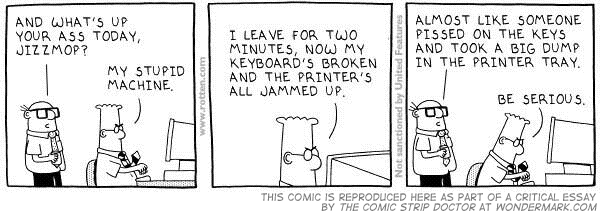
(Click any of the smaller images to zoom in on them.)
Caution: Some of the content explored in today’s column is definitely not “family-friendly.” But, you know, it’s the Internet, so you should probably be on your guard anyhow.
Author’s Note: This article predates, and in fact quite possibly inspired, the “Garfield Minus Garfield” phenomenon.
I’m hardly the first to be dissatisfied with the quality of the comics I read, and so it should be no surprise to anyone that there are many, many people who do the same thing I do: re-write the comics to make them funnier. In fact, the number of readers who take the mission of comic writing into their own hands has skyrocketed among Internet communities in the last few years; messageboards and blogs are full of doctored strips. (That doesn’t mean you can stop reading my column.)
Predictably, the most common strip to be re-written is the one that’s a poster-child for insipid humor: Bil Keane’s The Family Circus. It’s remarkably easy, too: simply strip off the caption at the bottom and fill-in-the-blank. Popularly known as “The Dysfunctional Family Circus,” the iconic circular comic about a family of saccharine know-it-alls began to appear with tasteless, irreverent and outright vulgar captions in ‘zines decades ago, eventually migrating to Usenet and, later, the World Wide Web.
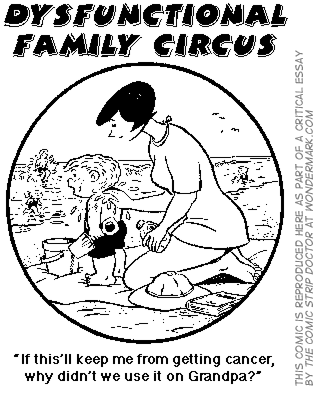
Of course, outright mockery coupled with widespread exposure begat the inevitable cease-and-desist letters, which is why I maintain on this site at least a thin veneer of academic criticism.
Eventually, it took Bil Keane himself speaking with webmaster Greg Galcik for The Dysfunctional Family Circus to be taken offline, but like any good meme, the concept proved impossible to kill. It’s possible now to find half-a-dozen websites that keep up the theme, essentially turning the daily comic strip into a never-ending caption contest.
Which, Galcik believes, is detrimental to the cause of parody. His site was the first of many to welcome audience submissions, but he only chose the best, to keep the humor quotient relatively high: “Somewhere along the way,” Galcik told me, “it becomes a competition for the audience to see who can get captions accepted, and they start trying to out-funny each other. And around then, the humor really starts to get complex.”
The paradox, of course, is that the more well-known (and, in the case of The Family Circus, aesthetically bankrupt) the original product, the riper a fruit it is for subversion — and the more fierce the lawyers that “protect” it. Galcik received the call himself. “Unfortunately, the assumption is that, if anyone does something that can possibly produce a profit on their material, it must be shut down before it becomes a precedent,” he said.
U.S. copyright law states that one of the criteria against whether a parody of a property can be considered “fair use” is whether it would hurt the original’s chances of making money. But recontextualized comics are rarely about profit — they’re about a different way of seeing the familiar; a more purely qualitative exercise, to use highfalutin’ terms. For example, recently blogger “Robyn” mashed-up The Family Circus with H.P. Lovecraft’s overwrought prose to create The Nameless Dread (a.k.a. “The Cthulu Circus”):
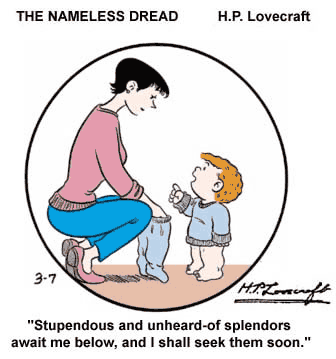
She took it down quickly once it got spread around, fearful of lawyers and, perhaps, internet celebrity. It’s a one-note joke that’s relatively funny nonetheless; like The Dysfunctional Family Circus, it relies on the disconnect that occurs between the source material — and the expectations the reader brings to it — and the caption. While the DFC subverts the convention that The Family Circus is wholesome, cutesy, and non-racist, The Nameless Dread has the Circus’ s typically mealy-mouthed, borderline-retarded children reciting what is perhaps the English language’s most dense epic poetry. The humor in the latter exists only because of the juxtaposition; it’s almost purely conceptual.
The Dilbert Hole is another experiment in offensiveness that quickly became an Internet phenomenon. There’s a psychological reason that recontexualized comics resonate with an audience: it’s the same reason people buy tabloids, to see celebrities at their worst. It’s the train-wreck joy of seeing something popular that you can’t stand become its complete, wretched opposite — and, of course, poop jokes seal the deal:
Like the online Dysfunctional Family Circus, The Dilbert Hole was quickly pounced upon by syndicate lawyers and summarily cease-and-desisted. Unlike the DFC, The Dilbert Hole was a meticulous reproduction of Scott Adams’ Dilbert, down to the lettering — save for the content, it could easily have been mistaken for the real thing. The precision made the parody more striking, but also the case against its creator more airtight.
The Dilbert character is a well-known figure to the remix crowd — equal parts cubicle hero and over-merchandised dreck. He’s their only champion in the working world, and he’s a sellout. In 1997, Leisuretown creator Tristan A. Farnon was sick of it, and The Dilbert Hole appeared as the creation of a disaffected cubicle drone in an underground comic entitled A Comedy Crisis. Farnon tells the story in an interview with The Comics Journal:
I’m allowed to disrespect Dilbert if I want to, I’ve suffered through years of insipid Dilbert-related merchandise staring at me from other people’s cubicles. I’ve worked on software products code-named “Dogbert.” It just got annoying. After awhile each strip ballooned up with industry keywords, and they grew indistinguishable from any other rectangle of syndicated bumper-sticker humor. Let’s all honk if we love Dilbert.
Farnon’s comics deliberately comment, in a satirical sense, on the culture that surrounds Dilbert. It is legitimate parody. And notably (and surprisingly, considering its vulgarity), The Dilbert Hole is genuinely funny. Its punchlines are tight and its comedic timing is right-on. Most of the more recent, knock-off Dysfunctional Family Circus strips floating around online are merely vulgar or offensive, with no humor to back them up.
This type of “dirtying up” a well-known property is the lowest form of parody, barely above the penises scrawled on the faces of celebrities on bus-stop movie posters. Dilbert’s lawyers had nothing to say about Farnon’s social commentary but everything to say about his use of the word “flatulence” in a facsimile of Scott Adams’s handwriting. The dirtiness makes the point and breaks the case. More sophisticated humor makes for better parody, says Galcik, but adds, “Experience tells me there are too many people who don’t agree with me, and they breed faster than I do.”
For example, Fred Basset Upfucked, which rewrites the dialogue of the continuing adventures of the world’s most boring dog — and which basks in so much legal paranoia that it claims “PARODY” in bold letters across the strip itself:
The creator claims that in his continuity, the titular hound is the reincarnation of Adolf Hitler. So far I haven’t seen much wit in evidence, although the strip does have its moments.
Such parodies have existed as long as there have been media to parody; “dirty” versions of Mickey Mouse, created by Disney animators after hours, have been around since the ’30s. Dan O’Neill’s Air Pirates comics of the 1970s painted Mickey and Minnie as dope smugglers; the resultant lawsuit set the tone for a vicious corporations vs. underground-comix sentiment that still persists today.
Although most of Disney’s famous works are adaptations of public-domain folktales or (as in Steamboat Willie) parodies of contemporaneous films, in recent years Disney’s corporate muscle has successfully lobbied for U.S. copyright law to be amended so that their own, highly lucrative, highly merchandisable properties do not fall outside of copyright protection. Comics syndicates are no different: they protect their properties vigorously from being represented, or remixed, in any way — over the protests of an audience that could breathe new life into tired characters.
The Garfield Randomizer is a webpage that accesses the comprehensive online Garfield archives, fetching one panel at a time from different individual Garfield strips and presenting them mashed-up and reordered into surreal, dada creations. An instant online hit, screen-captures of the recontextualized comics began appearing on messageboards and blogs everywhere. Of course, it didn’t take long for syndicate lawyers to pounce.
Which is unfortunate, both for fans and for the syndicate’s ailing, unfunny property. The unanimous sentiment online was that for the first time in years, Garfield was funny again. As I mentioned in my recent revision to the Comic Strip Doctor column on Garfield, what makes the randomized strips hilarious is that they break down the rhythms and cadences that readers have come to predict. First panel set-ups become final panel non sequiturs, or a strip may have three punchlines with no setup. Each panel’s utility is boosted by its becoming a modular component.
Interestingly, it’s easy to see how changing just the panel order, and thus the rhythm, of an otherwise unmodified Garfield strip can give it a wholly different tone:
This concept extrapolated to include combinations of strips can lead to wildly bizarre juxtapositions:
And, at times, surreally profound moments:
One thing I noticed, frantically creating new strips for hours on end in a vicious giggling fit, was that there are a lot of really strange concepts buried in the Garfield archives. The comic seems like it should be funny. How could a comic that incorporated any of the following panels not be funny?
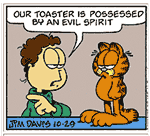

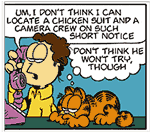
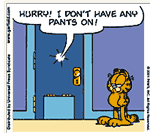
Somehow, Garfield manages. And the secret, it turns out, is through overkill:
Here, the punchline is set up twice and delivered twice (visually and through dialogue). As Eric Burns pointed out, often saying less is much more effective. It allows the reader to connect the dots, and engages them in the narrative. It leaves room for interpretation, and for Garfield’s true thoughts to only sound in the theater of the reader’s mind.
Garfield has been deconstructed before in this way, among many others, by Jack Masters on his site CastleZZT, but the particular trick of silencing Garfield — so that we see the world through Jon’s eyes — has gained prominence recently thanks to this forum thread. Silent Garfield becomes a mugging mime, a lethargic Charlie Chaplin. Sometimes (usually in the strips without Jon — who is, of course, now our protagonist), the results don’t quite work:
And sometimes they do:
The former example above is still amusing because, like the randomizer, it’s shifting up the usual cadences the reader expects from the Garfield comic strip. It’s absurd-funny (although, upon reflection, if you think he’s waving in the third panel, that’s sort of humorous). But the latter example is funny on its own. Instead of Garfield getting the snarky last word, here Jon speaks to a silent cat, and the lack of response or double punchline in the third panel seems to indicate that it’s not a joke, that the sad scene set up in the first two panels is just life as it is. Which, of course, is funny — because it’s giving us a window into a bizarre world and treating it as “true,” instead of using it as a setup for a predictable, lame joke.
Still, a comic strip like this that ran in the newspaper every day would be pretty dumb. The non-sequiturs and visual gags are still an awkward combination of postmodern non-humor and B-minus slapstick. They gain much of their traction from the comparison to the Garfield that we’re familiar with. That, after all, is why recontextualized comics are funny at all: they give us an alternate window, a “what-if,” into a paradigm that we know well. They reveal possibilities that might be, and recognize potential that goes untapped.
What I do with The Comic Strip Doctor is to try and mine some of that potential; in some cases it requires making a bit of a departure from the source material’s spirit, but I try not to simply make fun of bad comics. I try to make comics that are funny regardless of the existing associations we as readers have with them. Because I think that it’s possible to make good comics, and frankly there’s little excuse not to.
I think things like the Garfield Randomizer that become instantly popular can act as a guide towards what an audience finds funny. Granted, it’s an internet audience, so it’s probably on the whole younger and “hipper” and more cynical than the morning-oatmeal Garfield readers, but that’s precisely the crowd that always takes the culture handed them by the previous generation and remixes it and mashes it up and subtracts from it and adds to it and makes it their own for their generation.
The Garfield Randomizer was shut down with cease-and-desist letter sent to the webmaster. Never mind that the site did nothing but accessed the syndicate’s official archives; it did not modify the dialogue, or paint Garfield as a Nazi and Jon as a fan of bestiality. And never mind that, to many readers, “Garfield is finally funny again.”
“Of course the much more rational (and fun) way for it to be handled is with a basic sanity check,” says Galcik, of the syndicates’ knee-jerk reactions. “If the derivative is not harming the original, then leave ’em alone. But that’s just not possible with the way the system’s gone off level, now.”
My message to PAWS, Inc., corporate owner of the Garfield character, is: Learn to recognize a compliment. We like your stuff. It has meaning to us, both as individuals and as a culture. We grew up with your characters, and so they have an emotional resonance for us that overflows with potential.
Let them come out and play with us.
Until next time… I’ll see you in the funny papers.
— February, 2006
Author’s note, October 2008: Apparently heeding my advice, Jim Davis and PAWS, Inc. are releasing an officially-licensed version of the popular “Garfield Minus Garfield” Internet phenomenon.

